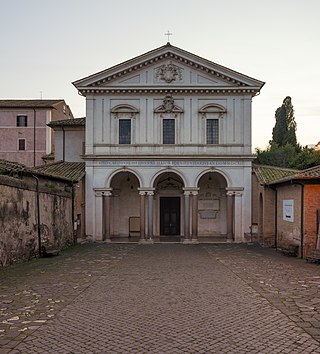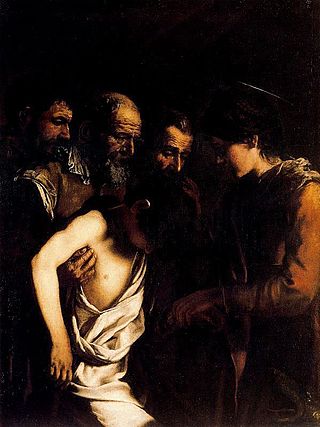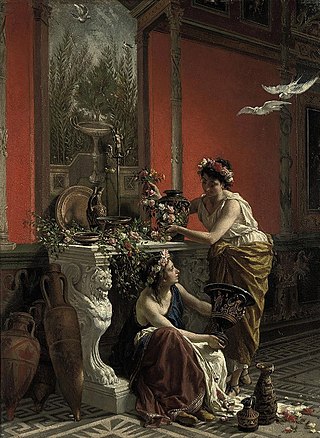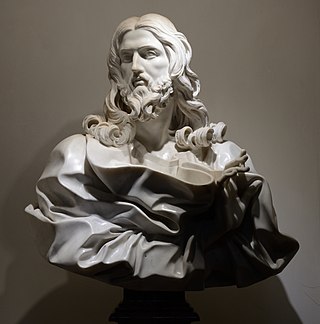Related Research Articles

Agnes of Rome is a virgin martyr, venerated as a saint in the Catholic Church, Oriental Orthodox Church and the Eastern Orthodox Church, as well as the Anglican Communion and Lutheran Churches. St. Agnes is one of several virgin martyrs commemorated by name in the Canon of the Mass.

Saint Lawrence or Laurence was one of the seven deacons of the city of Rome under Pope Sixtus II who were martyred in the persecution of the Christians that the Roman Emperor Valerian ordered in 258.

The Papal Basilica of Saint Paul Outside the Walls, commonly known as Saint Paul's Outside the Walls, is one of Rome's four major papal basilicas, along with the basilicas of Saint John in the Lateran, Saint Peter's, and Saint Mary Major, as well as one of the Seven Pilgrim Churches of Rome.

Saint Apollonia was one of a group of virgin martyrs who suffered in Alexandria during a local uprising against the Christians prior to the persecution of Decius. According to church tradition, her torture included having all of her teeth violently pulled out or shattered. For this reason, she is popularly regarded as the patroness of dentistry and those suffering from toothache or other dental problems. French court painter Jehan Fouquet painted the scene of St. Apollonia's torture in The Martyrdom of St. Apollonia.

The Basilica Papale di San Lorenzo fuori le mura is a Roman Catholic papal minor basilica and parish church, located in Rome, Italy. The Basilica is one of the Seven Pilgrim Churches of Rome and one of the five "papal basilicas", each of which was assigned to the care of a Latin Church patriarchate. The Basilica was assigned to the Patriarchate of Jerusalem. The Basilica is the shrine of the tomb of its namesake, Saint Lawrence, one of the first seven deacons of Rome who was martyred in 258. Many other saints and Bl. Pope Pius IX are also buried at the Basilica, which is the centre of a large and ancient burial complex.

The church of Saint Agnes Outside the Walls is a titulus church, minor basilica in Rome, on a site sloping down from the Via Nomentana, which runs north-east out of the city, still under its ancient name. What are said to be the remains of Saint Agnes are below the high altar. The church is built over the Catacombs of Saint Agnes, where the saint was originally buried, and which may still be visited from the church. A large basilica with the same name was built nearby in the 4th century and its ruins can be seen near Santa Costanza, in the same site. The existing church was built by Pope Honorius I in the 7th century, and largely retains its original structure, despite many changes to the decoration. In particular the mosaic in the apse of Agnes, Honorius, and another Pope is largely in its original condition. The current Cardinal Priest of the Titulus S. Agnetis Extra moenia is Camillo Ruini.

As the home of the Pope and the Catholic curia, as well as the locus of many sites and relics of veneration related to apostles, saints and Christian martyrs, Rome had long been a destination for pilgrims. The Via Francigena was an ancient pilgrim route between England and Rome. It was customary to end the pilgrimage with a visit to the tombs of Saints Peter and Paul. Periodically, some were moved to travel to Rome for the spiritual benefits accrued during a Jubilee. These indulgences sometimes required a visit to a specific church or churches. Pilgrims need not visit each church.

There are more than 900 churches in Rome. Most, but not all, of these are Catholic.

San Sebastiano fuori le mura, or San Sebastiano ad Catacumbas, is a Minor basilica in Rome, Central Italy. Up to the Great Jubilee of 2000, San Sebastiano was one of the Seven Pilgrim Churches of Rome, and many pilgrims still favor the traditional list.

Saint Emerentiana was a Roman martyr, who lived around the start of the 4th century. Her feast day is January 23.

The Minor Basilica of St. Mary in Domnica alla Navicella, or simply Santa Maria in Domnica or Santa Maria alla Navicella, is a Roman Catholic basilica in Rome, Italy, dedicated to the Blessed Virgin Mary and active in local charity according to its long tradition. It is one of the best examples of the so-called "Carolingian renaissance" in Rome. It has been the titular church of Cardinal Marcello Semeraro since 28 November 2020.
The Basilica di San Lorenzo may refer to one of the following churches:

Giovanni Serodine was a Swiss-Italian painter of the early Baroque period.

Cesare Mariani was an Italian painter and architect of the late-19th century, active in Rome and Ascoli Piceno.

The Niccoline Chapel is a chapel in the Apostolic Palace in Vatican City. It is especially notable for its fresco paintings by Fra Angelico (1447–1451) and his assistants, who may have executed much of the actual work. The name is derived from its patron, Pope Nicholas V, who had it built for use as his private chapel.
Abundius and Irenaeus were Roman martyrs during the reign of Roman Emperor Valerian (253-260). Their feast in the Roman Martyrology is celebrated on August 26. Abundius also has separate commemorations in Augsburg and Orvieto.

August 20 - Eastern Orthodox liturgical calendar - August 22

Stephen is traditionally venerated as the protomartyr or first martyr of Christianity. According to the Acts of the Apostles, he was a deacon in the early Church at Jerusalem who angered members of various synagogues by his teachings. Accused of blasphemy at his trial, he made a speech denouncing the Jewish authorities who were sitting in judgment on him and was then stoned to death. Saul of Tarsus, later known as Paul, a Pharisee and Roman citizen who would later become a Christian apostle, participated in Stephen's martyrdom.

The Bust of the Saviour (Salvator Mundi) is the last sculpture created by baroque artist Gian Lorenzo Bernini, who died from the after-effects of a stroke, when the artist was 81 years old. He left the sculpture in his will to his friend and patron queen Christina of Sweden. Considered lost and "rediscovered" in 2001, by Francesco Petrucci, it is currently held in the basilica of di San Sebastiano fuori le mura a Roma.